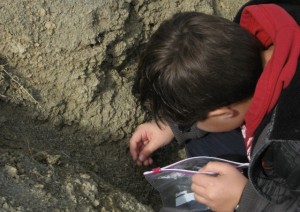Mineral Wells Fossil Park will capture young paleontologists’ imaginations. Fossil hunters can search for treasures, and the best part, you can keep whatever you find. Located just 80 miles west of Dallas, Mineral Wells Fossil Park opened to the public in 2010.
Park history. The Dallas Paleontological Society, City of Mineral Wells and Mineral Wells Chamber of Commerce partnered to create the park at the site of the city’s old borrow pit. Years ago, the town used earth dug from the area, the borrow pit, for dirt fill at the city dump. The pit was then closed in the 1990s and forgotten. Twenty years of rain and wind eroded the borrow pit’s sides exposing mineralized fossils in among shale and dirt.
No dinosaurs here. The best fossil hunting follows strong rains. The rain washes away dirt exposing the fossils on the ridges and in the troughs of furrows throughout the  borrow pit. Readily visible, the fossils are intermixed with small rocks. You aren’t likely to find a dinosaur here. The fossils are small, mostly crinoids (sea lily) fragments. While small, the crinoids and shells are everywhere you search. In just a few hours, our family had two sandwich bags filled with small fossils ranging in size from a pea to half dollar.
borrow pit. Readily visible, the fossils are intermixed with small rocks. You aren’t likely to find a dinosaur here. The fossils are small, mostly crinoids (sea lily) fragments. While small, the crinoids and shells are everywhere you search. In just a few hours, our family had two sandwich bags filled with small fossils ranging in size from a pea to half dollar.
The fossils are about 300 million years old. During the Pennsylvania Period, ancient sea lilies, urchins, clams, oysters, sea snails and sharks lived where prickly pear cactus thrive today. One such sea basin submerged the area around Mineral Wells. When the creatures died, their bodies fell to the sea floor. Minerals replaced the animals’ cellular material leaving behind a rock record for us to find millions of years later.
Fast forward from the ancient sea to the City of Mineral Wells old borrow pit. Sea creature fossils are so plentiful at Mineral Wells Fossil Park, that visitors for decades will be able to explore the past and collect ancient fragments of species long extinct. A large exhibit sign at the park entrance illustrates with photographs and descriptions the types of fossils commonly found at the site.
Fossil hunting guidelines. Mineral Wells Fossil Park has a few rules in place to ensure the park’s continued success. While you may keep whatever fossils you find, they must be for your personal use. No commercial fossil hunting is allowed. Park rules forbid power tools and limit guests to hand-held tools like a garden trowel. After a good rain, the hand shovels aren’t even necessary.
When you go. There is no shade at the park – hat, sunscreen and lots of water are a must on hot days. Wear old clothes for digging in the dirt and boots are a good idea if it’s recently rained. Additionally, bring plenty of small baggies for storing your fossils. As in other parts of Texas, be alert for stinging insects and snakes. Called a primitive park, Mineral Wells Fossil Park has no running water or flush toilets, though there is a portable toilet in the parking lot. For those wanting a more scenic location for a picnic, visit Lake Mineral Wells State Park (Park Road 71, Mineral Wells), located just east of Mineral Wells.
Mineral Wells Fossil Park (2375 Indian Creek Road, Mineral Wells) is open Friday – Monday from 8 a.m. to dusk. Park entrance is free.



